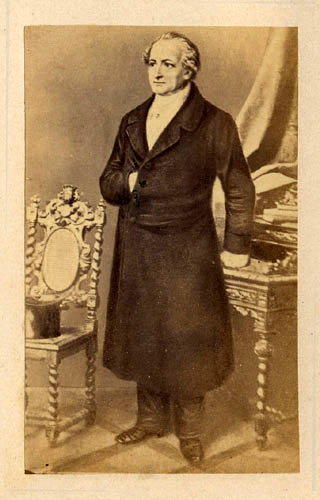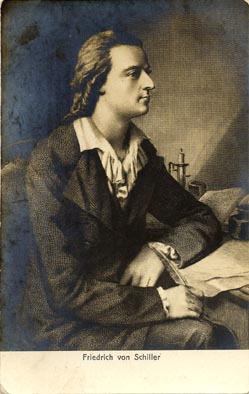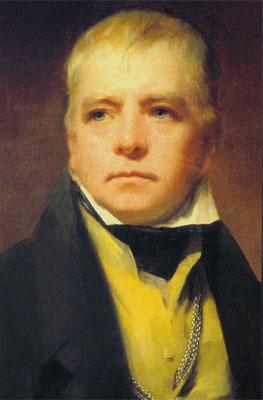Unless otherwise stated all pictures on Berlioz Photos page have been scanned from engravings, paintings, postcards and other publications in our own collection. All rights of reproduction reserved.
This page contains images of the following writers and poets: Goethe, Schiller, Walter Scott, and Victor Hugo
![]()

The above carte de visite (CDV), from our collection, was published in the 1860s.
Berlioz relates in his Memoirs the great and lasting impact made on him in 1828 by his reading of Goethe’s Faust in the French translation by Gérard de Nerval; this prompted him to write and publish his Huit scènes de Faust, though he then became dissatisfied with the work and withdrew it (chapter 26). He does not mention there that he sent a copy of the work to Goethe himself, who failed to respond to his letter (CG no. 122, 10 April 1829). In 1843, in the course of his first trip to Germany, Berlioz visited Weimar and was able to see for himself Goethe’s houses there, the house in town and his country cottage in the park. A few years later he then took up again the subject of Faust and developed it into la Damnation de Faust which utilised in a modified form the music of the earlier Huit scènes de Faust (Memoirs, chapter 54). — See in general the page Goethe and Schiller in Weimar, and see also on this site Berlioz and Goethe – Eugène Delacroix Lithographs and Berlioz and Goethe – Other paintings.

The above postcard was published in 1900. There is no information on the back of the card about the artist and date of the original portrait.

This early 20th century postcard in our collection is a reproduction of an engraving showing Schiller in his study, drawn probably in the late 18th or early 19th century. We have not been able to establish the identity of the artist.
Berlioz admired Schiller and was familiar with his works (in translation); in 1833 he planned a dramatic scene. Les Brigands, after Schiller’s Die Räuber, but the work was not completed. During his trip to Weimar in 1843 he was able to visit the house where Schiller lived from 1802 to his death in 1805, which drew from him the following comment: ‘These two little windows provide air to the miserable attic in which Schiller lived! It is in this modest dwelling that the great poet of noble impulses wrote Don Carlos, Mary Stuart, The Brigands, Wallenstein! That is where he lived as a poor student! (Memoirs, Third Letter from Germany). — See in general the page Goethe and Schiller in Weimar.

The original painting, by Andrew Geddes (c. 1818), is in the Scottish National Portrait Gallery, Edinburgh.
Berlioz’s correspondence shows by the mid 1820s Berlioz was an avid reader of Scott’s novels, which were published in France in translation and enjoyed wide popularity. In a letter to his sister Nancy Berlioz assumes that she is familiar with Scott’s novels and describes Walter Scott as ‘this giant of English [sic] literature’ (CG no. 75, 4 June 1827). In 1826 he planned to write an opera, Richard en Palestine, that was derived from Scott’s The Talisman, as evidenced by a series of letters to the writer Léon Compaignon between May 1826 and February 1827 (CG nos. 55-60, 62, 64-5, 67, 70, 72). In one of these letters he writes ‘We must take good care of the musical side so that I can do something worthy of Walter Scott’ (CG no. 56); in the event the project fell through. Berlioz was more successful with his own unaided efforts at setting Scott to music: he completed the overture Waverley around 1827, and while in Italy in 1831-2 wrote another Scott-based overture, Rob Roy MacGregor. The Waverley overture was eventually published in 1839, but it received few performances in Berlioz’s lifetime, and Berlioz does not seem to have regarded it very highly. As for the Rob Roy overture Berlioz withdrew it after only one performance (some of its music was re-used in Harold en Italie). It is noticeable that mentions of Walter Scott become very rare in Berlioz’s correspondence after the 1820s, unlike the major writers he discovered in the late 1820s, Shakespeare and Goethe, who inspired him to write some of his greatest music. — For a comprehensive account of the life and works of Sir Walter Scott see the Edinburgh University Library’s Walter Scott Digital Archive.

The above picture has been scanned from an information document published by the Abbotsford charitable trust; Abbotsford, located in Melrose, Scotland, was the home of Sir Walter Scott.

A copy of this lithograph by Devéra, which dates from 1829, is in the Musée Hector Berlioz at La Côte Saint-André. We thank Mme Chantal Spillemaecker, Conservateur du Musée Hector-Berlioz, for allowing us to reproduce this image.
To judge from his surviving correspondence, it was at the beginning of 1829, if not earlier, that Berlioz discovered the poetry of Victor Hugo. In a letter to his friend Humbert Ferrand dated 2 February 1829 he mentions his enthusiasm for the collection of poems Les Orientales which had just been published (‘There are thousands of sublime things there’) and says that he has set the pirates’ song to music (CG no. 113; this work is now lost). Henceforward he follows avidly Hugo’s latest publications: the next month he asks his sister Nancy whether she has read Le Dernier jour d’un condamné (CG no. 120, 29 March). A year later, in answer to a query from the same Nancy, he gives his opinion on the new play Hernani which had created a furore in Paris; his views were in fact mixed — he was critical of Hugo’s style of versification, though praised him for challenging long-established theatrical conventions (CG no. 159, around 20 April 1830). While away in Italy in 1831 be was frustrated at not being able to read immediately Notre Dame de Paris (CG nos. 231, 238) and when he eventually obtained a copy wrote an effusive letter to Victor Hugo, whom he had yet to meet (CG no. 254, 10 December 1831). In February 1832, still in Italy, he set to music the song la Captive, which proved an instant success at the Villa Medici (Memoirs, chapter 39; the work underwent several revisions subsequently). On his return to Paris, he finally met Victor Hugo on the occasion of the concert on 9 December 1832 at which the Symphonie fantastique was performed for the first time with its new sequel le Retour à la vie.
The subsequent relations between the two men can be followed intermittently through Berlioz’s correspondence. They were cordial rather than warm, and based on mutual respect and admiration. Berlioz admired Hugo’s work, as shown by numerous citations or allusions in his own writings. In October 1833 Berlioz attended a reading by Hugo of his drama Marie Tudor (CG nos. 348, 349). In 1834 he set to music another one of Hugo’s poems, Sara la baigneuse, which like la Captive, underwent several revisions subsequently. On several occasions he expressed his admiration directly to Hugo: ‘the most ardent genius of our time’ (CG no. 344, 7 September 1833); ‘your wonderful poetry’ (CG nos. 450, 452, December 1835); his emotion on reading Ode à la Colonne (CG no. 713, 5 May 1840). In April 1835 Berlioz approached Hugo with a request for a role suitable for Harriet Smithson, though nothing came of this (CG no. 445). Other meetings are attested from time to time (e.g. CG nos. 765, 5 February 1842; 1270, July 1849 or 1850).
On his side Victor Hugo, though not a musician himself, paid attention to Berlioz’s work and attended some of his concerts: that of 9 December 1832 mentioned above, one on 22 December 1833 to which Berlioz had invited him (CG nos. 367, 370), probably one on 22 November 1835, for which he thanked Berlioz with the gift of a volume of poetry (CG nos. 450, 452). He missed the performance of the Requiem in December 1837, though his wife was able to attend and congratulated Berlioz (CG no. 526), He also missed a later concert on 15 February 1842, though sent friends in his place (CG no. 766). But he did attend one of the performances of Benvenuto Cellini in September 1838 and sent Berlioz a warm letter of encouragement (CG no. 566). It seems that in 1844 Berlioz sent Hugo a copy of his treatise on orchestration, though what Hugo made of it is not clear (CG no. 885, 14 February 1844). After the revolution of 1848 Hugo rendered Berlioz a great service in using his influence to save his post as librarian of the Conservatoire (Memoirs, chapter 48).
On a personal level Berlioz was probably closer to writers such Balzac or Gautier, for example, than he ever was to Victor Hugo. In a letter of 1834 he remarks ‘I rarely see Hugo, he is too magisterial’ (CG no. 408, 31 August). A letter of 1850 describes in some detail an evening spent at the Hugos which he did not enjoy: the ladies were charming but the two sons unsufferable, and as for Hugo himself ‘he was very cordial with me, as he has always been, though he is solemn’, and Berlioz regretted not being able to talk as freely with him as when he met him casually in the street (CG no. 1319, 1st April). The following year (11 December 1851) Hugo went into exile in protest against the seizure of power by Napoleon III, and did not return to France till after the death of Berlioz; Berlioz for his part was politically on the other side of the fence and supported the rule of the new emperor (cf. CG no. 1872, 2 January 1855). — See also on this site Berlioz and Victor Hugo.

![]()
© (unless otherwise stated) Monir Tayeb and Michel Austin for all the texts and images on Berlioz Photo Album pages.
All rights of reproduction reserved.